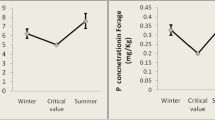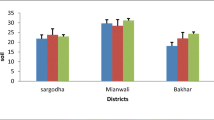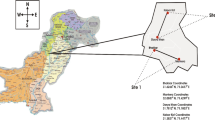Summary
The macro mineral status of cattle in the Selale highlands of Ethiopia was evaluated during the rainy and dry seasons of 1989 and 1990 in terms of mineral concentrations in soils, feeds, blood plasma and faeces on 25 farms. Bone samples from animals of local breeds from a slaughter house were collected during the rainy and dry seasons of 1990. Soils were analysed for pH, organic matter, Ca, P, Mg, Na and K. The results indicated wide variation in the concentrations of minerals on different farms. Available feeds in the area consist of pasture, hay, the straw of barley, oats and teff, and the grains of barley and oats. Pasture grass and other feeds were found to be deficient in Na, P and Mg in relation to dietary requirements.
Analyses of blood plasma from crossbred and local cattle showed that a number of samples contained P below the critical level of 1·45 mmol/litre. Effects of year and season were significant for Ca, P, Mg and K. The effect of age was significant for P (P<0·001). Faecal analyses revealed that about 80% of animals were deficient in Na.
Wide variations in the mineral content of soils and lack of significant correlations among soil, pasture and blood plasma indicated that soil and pasture analyses are not reliable in assessing macro mineral status of grazing cattle in this environment. Analyses of bone and blood for Ca and P, blood for Mg and faeces for Na appear to provide better indices.
Résumé
La teneur en macroéléments minéraux dans les Hautes Terres du Selale en Ethiopie pendant les saisons humides et sèches des années 1989 et 1990, en termes de concentrations minérales dans les sols, les aliments du bétail, le plasma sanguin et les fèces a été évaluée sur 25 fermes. Des prélèvements d'os sur des animaux de races locales ont été effectués à l'abbatoir pendant les saisons sèches et humides en 1990. Les sols ont été analysés pour y rechercher les teneurs en matière organique, calcium, phosphore, magnésium, sodium et potassium et pour mesurer le pH. Les résultats montrent d'une ferme à l'autre de larges variations de la concentration minérale. Les aliments disponibles dans la région consistent en fourrages, en foin, en feuilles et grains d'orge et d'avoine.
L'herbe des pâturages et les autres aliments sont carencés en sodium, potassium et magnésium par rapport aux besoins alimentaires.
Les analyses du plasma sanguin des bovins locaux et de leurs croissements ont montré que dans le nombre de prélèvements, le phosphore se situait au dessous du seuil critique de 1,45 mmol par litre. Les effets de l'année et de la saison étaient significatifs pour Ca, P, Mg et K.
Le rôle de l'âge était également significatif pour le phosphore pourP<0,001. Enfin les analyses de fèces ont révélé une carence en sodium dans environ 80 p. 100 des cas. De larges variations dans le contenu minéral des sols et le manque de corrélations significatives entre le sol, le pâturage et le plasma sanguin ont révélé que les analyses du sol et du pâturage n'étaient pas fiables pour déterminer les teneurs minérales en macroélements du bétail au pâturage dans cet environnement précis. La recherche du calcium et du phosphore dans les os et le sang d'une part, celle du magnésium dans le sang et du sodium dans les fèces semblent fournir de meilleures indications à cet égard.
Resumen
Se evaluó la composición mineral de macroelementos del ganado en las tierras altas de Selale en Etiopía, durante las estaciones lluviosas y secas de 1989 y 1990 en términos de la concentración mineral en suelos, alimento, plasma sanguíneo y heces, en 25 fincas. Se colectaron muestras de hueso de animales criollos en el matadero, durante las estaciones lluviosa y seca de 1990. Los suelos fueron analizados para determinar el pH, la materia orgánica, Ca, P, Mg, Na y potásio. Los resultados indicaron una amplia variación en la concentración de minerales en diferentes fincas. Los alimentos disponibles en el área consistían en pasturas, heno, la paja de cebads, y avena, y los granos de trigo y avena y ‘teff’ grass o pasto cereal africano. Las pasturas se encontraron deficientes, así como también otros alimentos en Na, P y Mg en relación con los requerimientos dietéticos.
El análisis del plasma sanguíneo del ganado cruzado y criollo, dieron como resultado un número de muestras por debajo de los niveles críticos de 1·45 mmol/litro. Los efectos del año y la estación fueron significativos para Ca, P, Mg y K. El efecto de la edad fue significativo para el fósforo (P<0·001). El análisis de materia fecal reveló, que cerca de 80% de animales fueron deficientes en sodio.
Las variaciónes amplias en el contenido mineral de suelos y la falta o corrielaciones significativas entre suelo pastos y plasma sanguíneo no son confiables para determinar el estado mineral de macro elementos del ganado en pastoreo en este ambiente. El análisis del hueso y de la sangre para Ca, y P, sangre para Mg y heces para sodio provee mejores índices.
Similar content being viewed by others
References
Ammerman, C. B., Loaiza, J. M., Blue, W. G., Gamble, J. F. &Martin, F. G. (1974). Mineral composition of tissues from beef cattle under grazing conditions in Panama.Journal of Animal Science,38, 158–162.
Ammerman, C. B., Valdivia, R., Rosa, I. V., Henry, P. R., Feaster, J. P. &Blue, W. G. (1984). Effect of sand or soil as a dietary component on P utilization.Journal of Animal Science,59, 1092–1099.
Bray, R. H. &Kurtz, L. T. (1945). Determination of total, organic and available forms of phosphorus in soils.Soil Science,59, 39–45.
Chamberlain, G. T. (1955). The major and trace element composition of East African feeding stuffs.East African Agricultural Journal,20, 103–107.
Dougall, H. W. &Bogdan, A. V. (1958). The chemical composition of grasses of Kenya.East African Agricultural Journal,24, 17–23.
French, M. H. (1955). Earth eating and the mineral needs of livestock.East African Agricultural Journal,20, 168–175.
Healy, W. B. (1968). Ingestion of soil by dairy cows.New Zealand Journal of Agricultural Research,11, 487–499.
Howard, D. A., Burdin, M. L. &Lampkin, G. H. (1962). Variation in mineral and crude protein contents of pastures at Muguga in the Kenya highlands.Journal of Agricultural Science,59, 251–256.
Kabaija, E. &Little, D. A. (1988). Nutrient quality of forages in Ethiopia with particular reference to mineral elements. Proceedings of the 3rd workshop held at the International Conference Centre, Arusha, Tanzania. Pastures Network for Eastern and Southern Africa (Panesa). International Livestock Center for Africa (ILCA), Addis Ababa. pp 423–427.
Kemp, A. (1960). Hypomagnesaemia in milking cows: the response of serum Mg to alterations in herbage composition resulting from K and N dressings on pasture.Netherlands Journal of Agricultural Science,8, 281–304.
Khalili, M., Capper, B. &Lindgren, E. (1992a). Sodium status of crossbred Fresian × Zebu (Boran) calves fed roughage-based diets using faecal Na content as indicator.Swedish Journal of Agricultural Research,22, 85–90.
Khalili, M., Varvikko, T. &Lindgren, E. (1992b). The use of faecal Na concentration as an indicator of Na status in lactating crossbred cows.Swedish Journal of Agricultural Research,22, 91–96.
Khalili, M., Lindgren, E. &Varvikko, T. (1993). A survey of mineral status of soils, feeds and cattle in the Selale Ethiopian highlands: II. Trace elements.Tropical Animal Health and Production (In press).
Kiatoko, M., McDowell, L. R., Bertrand, J. E., Chapman, H. L., Pate, F. M., Martin, F. G. &Conrad, J. H. (1982). Evaluating the nutritional status of beef cattle herds from four soil order regions of Florida. I. Macroelements, protein, carotene, vitamin A and E, hemoglobin and hematocrit.Journal of Animal Science,55, 28–37.
Little, D. A. (1968). Effect of dietary phosphate on the voluntary consumption of townsville lucerne (Stylosanthes humilis) by cattle.Proceedings of Australian Society of Animal Production,7, 376–380.
Little, D. A. (1987). The influence of Na supplementation on the voluntary intake and digestibility of low-NaSetaria sphacelata cv. Nandi by cattle.Journal of Agricultural Science, Cambridge,108, 231–236.
Long, M. I. E., Thornton, D. D., Ndyanabo, W. K., Marchall, B. &Ssekaalo, H. (1970). The mineral status of dairy farms in the parts of Buganda and Busorga bordering Lake Victoria, Uganda.Tropical Agriculture (Trinidad),47, 37–50.
Long, M. I. E., Marshall, B., Ndyanabo, W. K. &Thornton, D. D. (1972). The mineral status of dairy farms in eastern Uganda. Nitrogen and mineral content of grasses and some mineral contents of bovine plasma.Tropical Agriculture (Trinidad),49, 227–234.
McDowell, L. R. (1985).Nutrition of Grazing Ruminants in Warm Climates. (Ed L. R. McDowell), Academic Press, Orlando, Florida.
Metson, A. J., Saunders, W. M. H., Collie, T. W. &Graham, V. W. (1966). Chemical composition of pastures in relation to grass tetany in beef breeding cows.New Zealand Journal of Agricultural Research,9, 410–436.
Morris, J. G. (1980). Assessment of Na requirements of grazing beef cattle: A review.Journal of Animal Science,50, 145–152.
Mtimuni, J. P. (1982). Identification of mineral deficiencies in soil, plant and animal tissues as constraints to cattle production in Malawi. PhD. thesis. University of Florida, Department of Animal Science, Gainesville, Florida, USA.
Newton, G. L., Fontenot, J. P., Tucker, R. E. &Polan, C. E. (1972). Effects of high dietary potassium on the metabolism of magnesium by sheep.Journal of Animal Science,35, 440.
NRC (1989). National Research Council, Nutrient requirement of dairy cattle. Sixth revised edition updated 1989. National Academy Press, Washinton, D.C.
Prabowo, A., Salam, R., McDowell, L. R., Wilkinson, N. S. &Kawashima, T. (1989). Effects of soil ingestion and mineral supplementation on performance and mineral utilization in lambs. Proceedings of International Meeting on Mineral Nutrition and Mineral Requirements in Ruminants. Kyoto, Japan, 1989.
Sillanpāā, M. (1982). Micronutrients and the nutrient status of soils: a global study. FAO Soil Bulletin 48.
SAS, Statistical Analysis System (1988). SAS Institute Inc., Cary, NC, USA.
Tejada, R. (1984). Evaluation of the mineral status of cattle in specific regions in Guatemala. Ph.D thesis. University of Florida, Department of Animal Science, Gainesville, Florida, USA.
Underwood, E. J. (1981). The mineral nutrition of livestock. 2nd edition. Commonwealth Agricultural Bureau, London.
Walker, C. A. (1957). Studies of the cattle of Zambia 1. The growth of steers under normal veld grazing and supplemented with salt and protein.Journal of Agricultural Science,49, 394–400.
Walkley, A. &Black, E. A. (1934). An examination of the Degtjareff method for determining soil organic matter, and proposed modification of the chromic acid titration method.Soil Science,34, 29–38.
Wylie, M. J., Fontenot, J. P. &Green, L. W. (1985). Absorption of Mg and other macro minerals in sheep infused with K in different parts of the digestive tract.Journal of Animal Science,61, 1219–1229.
Author information
Authors and Affiliations
Rights and permissions
About this article
Cite this article
Khalili, M., Lindgren, E. & Varvikko, T. A survey of mineral status of soils, feeds and cattle in the Selale Ethiopian highlands. I. Macro elements. Trop Anim Health Prod 25, 162–172 (1993). https://doi.org/10.1007/BF02236235
Accepted:
Issue Date:
DOI: https://doi.org/10.1007/BF02236235




